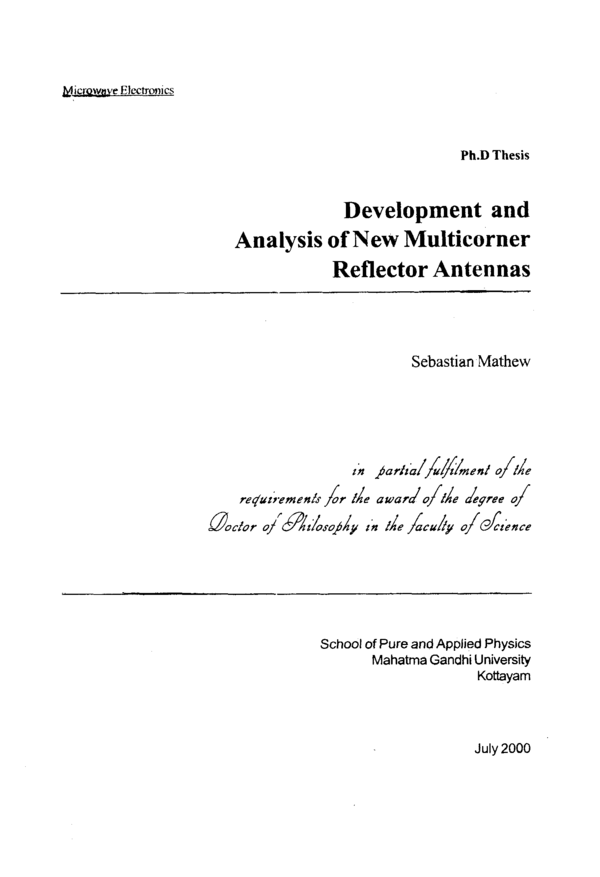| |||||||||||
- Title
- DEDICATION
- CERTIFICATE
- DECLARATION
- ACKNOWLEDGEMENT
- CONTENTS
- 1 Introduction
- 1.1 Types of antennas
- 1.1.1 Wire antennas
- 1.1.2 Aperture antennas
- 1.1.2.1 Reflector antennas
- 1.1.2.2 Plane reflectors
- 1.1.2.3 Corner reflectors
- 1.1.2.4 Curved reflectors
- 1.1.3 Leaky wave antennas
- 1.1.4 Transmission type antennas
- 1.1.5 Antenna arrays
- 1.1.6 Planar antennas
- 1.2 Outline of the present work
- 1.2.1 Chapter organisation
- 1.2.1.1 Chapter 2
- 1.2.1.2 Chapter 3
- 1.2.1.3 Chapter 4
- 1.2.1.4 Chapter 5
- 1.2.1.5 Chapter 6
- 2 Review of the past work in the field
- 3 Methodology
- 3.1 Experimental facilities
- 3.1.1 HP83508 Sweep oscillator
- 3.1.1.1 Start/stop mode
- 3.1.1.2 CF/ΔF mode
- 3.1.1.3 CW mode
- 3.1.2 HP87438 reflection transmission test unit
- 3.1.3 HP8411A harmonic frequency converter
- 3.1.4 HP8410C/8510B network analyser with display unit
- 3.1.5 Anechoic Chamber
- 3.1.6 Antenna positioner and controlIer
- 3.1.7 The X-Y recorder
- 3.2 Fabrication of antennas under test
- 3.2.1 The newly devoloped antennas
- 3.2.1.1 The ETCR Antenna
- 3.2.1.2 The PSACR Antenna
- 3.3 The antenna holder and feeding facility
- 3.4 Experimental set-up
- 3.4.1 C-Band antenna
- 3.5 Method of measurements
- 3.5.1 Antenna impedance and VSWR
- 3.5.2 Radiation pattern
- 3.5.3 Direction gain
- 3.6 Motivation for the present work
- 4 Experimental results
- 4.1 Introduction
- 4.2 The ECTR antenna
- 4.2.1 Dependence of βopt on width of the sub reflector and primary corner angle
- 4.2.2 Studies on the radiation patterns of the ETCR antenna
- 4.2.2.1 H-plane radiation patterns
- 4.2.2.2 Effect of variation of width of sub reflector on axial gain and half power beam width
- 4.2.2.3 Sidelobe Levels
- 4.2.3 VSWR and impedance
- 4.3 The periodic strip attached corner reflector (PSACR) antenna
- 4.3.1 Factors affecting optimumn β
- 4.3.2 Effect of strip parameters on the axial gain
- 4.3.2.1 Number of strips
- 4.3.2.2 Strip width
- 4.3.2.3 Strip periodicity
- 4.3.2.4 Strip Length
- 4.3.3 Effect of variation of width of the primary reflector on axial gain
- 4.3.4 Studies on the radiation patterns of the PSACR Antenna
- 4.3.4.1 Copolar radiation pattern
- 4.3.4.1.1 H-plane radiation pattern
- 4.3.4.1.1.1 Single Lobe radiation patterns
- Maximum sidelobe Levels
- The HPBW
- The twin lobe radiation pattern
- 4.3.4.1.2 E-plane radiation pattern
- 4.3.4.2 The cross-polar levels
- 4.3.5 Study of the impedance parameters
- 4.3.6 The C-band design
- 4.4 Comparison between PSACR and ETCR
- 4.5 Conclusion
- 5 Theoretical analysis
- 5.1 Introduction
- 5.2 Method of analysis
- 5.2.1 Geometrical optics field analysis (Image theoy)
- 5.2.2 Diffraction field analysis - GTD approach
- 5.2.2.1 Geometrical theory of diffraction for edges
- 5.2.2.2 Diffraction by a slit
- 5.3 Application of the new antennas
- 5.3.1 The ETCR
- 5.3.1.1 Case 1
- 5.3.1.2 Case 2
- 5.3.1.3 Case 3
- 5.3.2 The PSACR
- The GO field
- The diffraction field
- 5.3.2.1 Case 1.180 PSACR (axial single lobe)
- 5.3.2.2 Case 2.180 PASCR (Twin lobe radiation pattern)
- 5.3.2.3 Case 3.120˚ PSACR
- 5.3.2.4 Case 4. 90˚ PSACR
- 6 Conclusions
- 6.1 Introduction
- 6.2 Highlights of the results
- 6.2.1 Experimental observations
- (a) ETCR
- (b) PSACR
- 6.2.2 Theoretical conclusions
- 6.2.3 Shortcomings
- 6.3 Importance of the study
- 6.4 Possible applications
- 6.5 scope for further work
- References
- List of publications




 Full Screen
Full Screen


